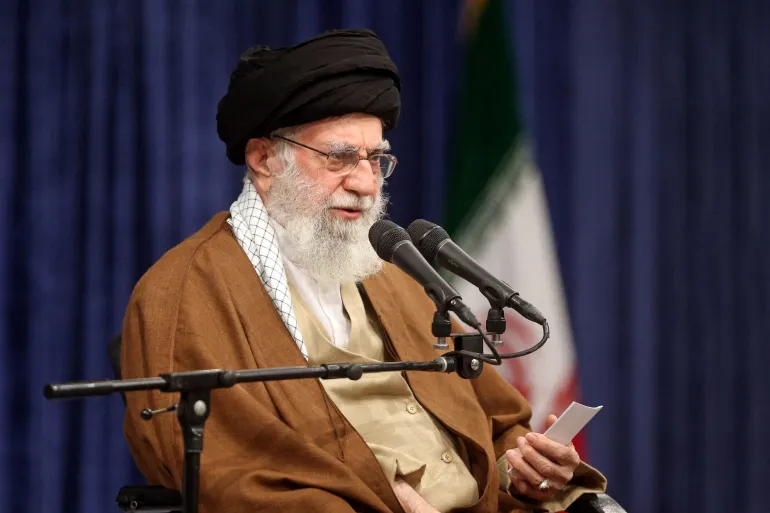The Iranian regime is facing mounting challenges as it grapples with a combination of economic turmoil, regional losses, and the anticipation of potentially tougher policies under a possible second Trump administration. Experts and analysts suggest that Tehran’s leadership is under “immense pressure,” with its stability being tested on multiple fronts.
The regime’s troubles stem from a confluence of internal and external factors, including sanctions-induced economic hardships, declining influence in the Middle East, and public dissatisfaction fueled by years of mismanagement and repression. The prospect of Donald Trump returning to the White House in 2025 has further unsettled Iranian leaders, given the former president’s history of implementing aggressive policies toward Tehran.
Economic Struggles Deepen
Iran’s economy remains in dire straits, burdened by U.S. sanctions and mismanagement. Inflation continues to skyrocket, eroding the purchasing power of ordinary Iranians. The national currency, the rial, has hit historic lows against the dollar, and unemployment rates are persistently high.
Despite attempts to circumvent sanctions by fostering trade with allies like China and Russia, Iran has struggled to generate sufficient revenue to stabilize its economy. Oil exports, once the backbone of Iran’s economy, have been severely curtailed, with the country resorting to smuggling and clandestine deals to keep its revenues afloat.
The economic crisis has fueled public discontent, leading to sporadic protests across the country. Citizens have expressed frustration not only with the regime’s economic policies but also with corruption and a lack of transparency.
Geopolitical Setbacks in the Region
Iran’s influence in the Middle East, a cornerstone of its foreign policy, has been waning. In Syria, Lebanon, and Yemen, where Tehran has invested heavily in proxy groups and military operations, it is facing resistance and diminishing returns.
- Syria: Iran’s support for Bashar al-Assad has come at a steep financial and reputational cost. While Assad remains in power, Iran’s resources have been stretched thin, and its presence is increasingly contested by other regional players, including Russia.
- Lebanon: Hezbollah, Iran’s key ally in Lebanon, is under immense strain as the country grapples with an unprecedented economic collapse. Public sentiment against foreign interference has grown, weakening Hezbollah’s standing.
- Yemen: Tehran’s backing of Houthi rebels in Yemen has drawn international condemnation and complicated its regional standing. Recent peace talks have sidelined Iran, with other Gulf states taking the lead in negotiations.
These setbacks have undermined Iran’s regional ambitions and its narrative of resistance against Western influence.
Impact of a Potential Second Trump Administration
The possibility of Donald Trump returning to the White House has added another layer of uncertainty for Tehran. During his presidency, Trump withdrew the U.S. from the 2015 nuclear deal and imposed a “maximum pressure” campaign of economic sanctions that crippled Iran’s economy. His administration also authorized the assassination of Qassem Soleimani, a top Iranian general, in 2020, dealing a severe blow to Iran’s military and strategic capabilities.
If Trump were to regain the presidency, analysts anticipate a renewed hardline approach toward Iran. This could include stricter sanctions, increased support for Iran’s regional adversaries, and a more aggressive stance on Iran’s nuclear ambitions.
“The regime in Tehran knows that a second Trump administration would bring more pressure than ever before,” said Behnam Ben Taleblu, a senior fellow at the Foundation for Defense of Democracies. “The fear is that they could face even harsher policies, further isolating them internationally and exacerbating their domestic challenges.”
Domestic Unrest and Public Dissatisfaction
Public discontent continues to simmer, fueled by widespread economic struggles and repression. Protests have erupted sporadically across the country, with demonstrators calling for greater freedoms, government accountability, and an end to corruption.
The regime has responded with its usual heavy-handed tactics, deploying security forces to suppress dissent. However, the persistence of these protests suggests a growing disconnect between the ruling elite and the Iranian populace.
What’s Next for Tehran?
The Iranian regime faces a precarious future as it contends with mounting economic, geopolitical, and domestic pressures. Its leaders are walking a tightrope, balancing internal stability against external threats.
As the world watches, Tehran’s next moves will likely be shaped by the outcome of the U.S. presidential election, developments in its regional engagements, and its ability to navigate the ongoing economic crisis. For now, the regime remains under immense pressure, with no clear path to relief in sight.

